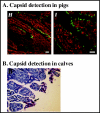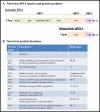Pathogenesis of noroviruses, emerging RNA viruses
- PMID: 21994656
- PMCID: PMC3185648
- DOI: 10.3390/v2030748
Pathogenesis of noroviruses, emerging RNA viruses
Abstract
Human noroviruses in the family Caliciviridae are a major cause of epidemic gastroenteritis. They are responsible for at least 95% of viral outbreaks and over 50% of all outbreaks worldwide. Transmission of these highly infectious plus-stranded RNA viruses occurs primarily through contaminated food or water, but also through person-to-person contact and exposure to fomites. Norovirus infections are typically acute and self-limited. However, disease can be much more severe and prolonged in infants, elderly, and immunocompromised individuals. Norovirus outbreaks frequently occur in semi-closed communities such as nursing homes, military settings, schools, hospitals, cruise ships, and disaster relief situations. Noroviruses are classified as Category B biodefense agents because they are highly contagious, extremely stable in the environment, resistant to common disinfectants, and associated with debilitating illness. The number of reported norovirus outbreaks has risen sharply since 2002 suggesting the emergence of more infectious strains. There has also been increased recognition that noroviruses are important causes of childhood hospitalization. Moreover, noroviruses have recently been associated with multiple clinical outcomes other than gastroenteritis. It is unclear whether these new observations are due to improved norovirus diagnostics or to the emergence of more virulent norovirus strains. Regardless, it is clear that human noroviruses cause considerable morbidity worldwide, have significant economic impact, and are clinically important emerging pathogens. Despite the impact of human norovirus-induced disease and the potential for emergence of highly virulent strains, the pathogenic features of infection are not well understood due to the lack of a cell culture system and previous lack of animal models. This review summarizes the current understanding of norovirus pathogenesis from the histological to the molecular level, including contributions from new model systems.
Keywords: calicivirus; norovirus; pathogenesis.
Figures








References
-
- Centers for Disease Control and Prevention Surveillance for foodborne disease outbreaks - United States. 2006. MMWR. 2009;58:609–615. - PubMed
-
- Green KY. Fields Virology. Lippincott Williams and Wilkins; Philadelphia, PA, USA: 2007. Caliciviridae: The Noroviruses; pp. 949–979.
-
- Parrino TA, Schreiber DS, Trier JS, Kapikian AZ, Blacklow NR. Clinical immunity in acute gastroenteritis caused by Norwalk agent. N Engl J Med. 1977;297:86–89. - PubMed
Grants and funding
LinkOut - more resources
Full Text Sources
Other Literature Sources

